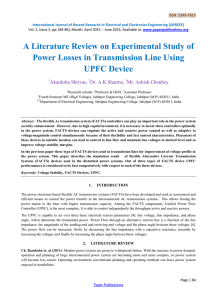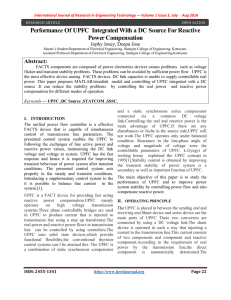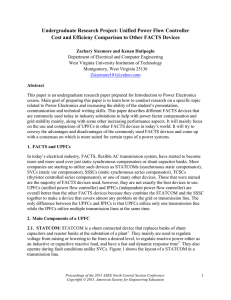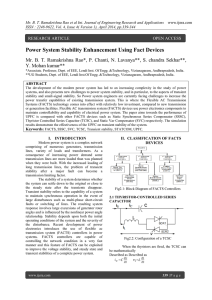IMPLEMENTATION OF UPFC MODEL INTO FAST DECOUPLED
advertisement
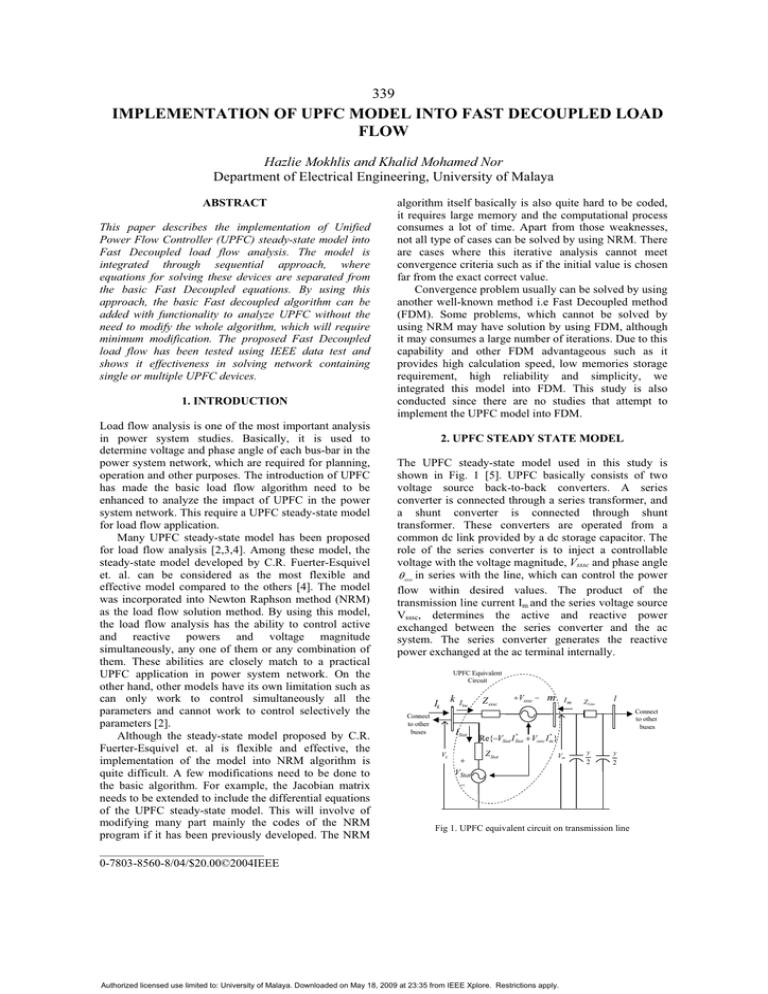
339
IMPLEMENTATION OF UPFC MODEL INTO FAST DECOUPLED LOAD
FLOW
Hazlie Mokhlis and Khalid Mohamed Nor
Department of Electrical Engineering, University of Malaya
ABSTRACT
This paper describes the implementation of Unified
Power Flow Controller (UPFC) steady-state model into
Fast Decoupled load flow analysis. The model is
integrated through sequential approach, where
equations for solving these devices are separated from
the basic Fast Decoupled equations. By using this
approach, the basic Fast decoupled algorithm can be
added with functionality to analyze UPFC without the
need to modify the whole algorithm, which will require
minimum modification. The proposed Fast Decoupled
load flow has been tested using IEEE data test and
shows it effectiveness in solving network containing
single or multiple UPFC devices.
1. INTRODUCTION
Load flow analysis is one of the most important analysis
in power system studies. Basically, it is used to
determine voltage and phase angle of each bus-bar in the
power system network, which are required for planning,
operation and other purposes. The introduction of UPFC
has made the basic load flow algorithm need to be
enhanced to analyze the impact of UPFC in the power
system network. This require a UPFC steady-state model
for load flow application.
Many UPFC steady-state model has been proposed
for load flow analysis [2,3,4]. Among these model, the
steady-state model developed by C.R. Fuerter-Esquivel
et. al. can be considered as the most flexible and
effective model compared to the others [4]. The model
was incorporated into Newton Raphson method (NRM)
as the load flow solution method. By using this model,
the load flow analysis has the ability to control active
and reactive powers and voltage magnitude
simultaneously, any one of them or any combination of
them. These abilities are closely match to a practical
UPFC application in power system network. On the
other hand, other models have its own limitation such as
can only work to control simultaneously all the
parameters and cannot work to control selectively the
parameters [2].
Although the steady-state model proposed by C.R.
Fuerter-Esquivel et. al is flexible and effective, the
implementation of the model into NRM algorithm is
quite difficult. A few modifications need to be done to
the basic algorithm. For example, the Jacobian matrix
needs to be extended to include the differential equations
of the UPFC steady-state model. This will involve of
modifying many part mainly the codes of the NRM
program if it has been previously developed. The NRM
algorithm itself basically is also quite hard to be coded,
it requires large memory and the computational process
consumes a lot of time. Apart from those weaknesses,
not all type of cases can be solved by using NRM. There
are cases where this iterative analysis cannot meet
convergence criteria such as if the initial value is chosen
far from the exact correct value.
Convergence problem usually can be solved by using
another well-known method i.e Fast Decoupled method
(FDM). Some problems, which cannot be solved by
using NRM may have solution by using FDM, although
it may consumes a large number of iterations. Due to this
capability and other FDM advantageous such as it
provides high calculation speed, low memories storage
requirement, high reliability and simplicity, we
integrated this model into FDM. This study is also
conducted since there are no studies that attempt to
implement the UPFC model into FDM.
2. UPFC STEADY STATE MODEL
The UPFC steady-state model used in this study is
shown in Fig. 1 [5]. UPFC basically consists of two
voltage source back-to-back converters. A series
converter is connected through a series transformer, and
a shunt converter is connected through shunt
transformer. These converters are operated from a
common dc link provided by a dc storage capacitor. The
role of the series converter is to inject a controllable
voltage with the voltage magnitude, Vsssc and phase angle
T sssc in series with the line, which can control the power
flow within desired values. The product of the
transmission line current Im and the series voltage source
Vsssc, determines the active and reactive power
exchanged between the series converter and the ac
system. The series converter generates the reactive
power exchanged at the ac terminal internally.
UPFC Equivalent
Circuit
k
Ik
Connect
to other
buses
I km
IStat
Vk
Z sssc
Vsssc m
Im
Z Line
l
Connect
to other
buses
*
Re{VStat I Stat
Vsssc I m* }
Z Stat
Vm
y
2
y
2
VStat
Fig 1. UPFC equivalent circuit on transmission line
_______________________________
0-7803-8560-8/04/$20.00©2004IEEE
Authorized licensed use limited to: University of Malaya. Downloaded on May 18, 2009 at 23:35 from IEEE Xplore. Restrictions apply.
340
3. MODIFICATION OF FAST DECOUPLED
ALGORITHM
In FDM load flow method, the two matrices equations to
be solved iteratively are:
>'P / V @ >B'@>'T @
3
4
['Q / V ] [ B" ]['V ]
where,
'P, 'Q : active and reactive power mismatch vectors
'V , 'T :voltage magnitude and angle correction vectors
Bik'
1 / X ik
Bii'
¦
Bik"
and
1 / X ik
X ik /
Bii"
and
ik
Rik2
¦
X ik2
5
6
Bik" S ik / 2
ik
In order to include UPFC into the FDM, the following
modifications are necessary;
The [k,k] element of matrix B” is included with the
impedance of UPFC on the shunt converter side as
follow:
"'
Bkk
"
Bkk
X Stat /
2
R Stat
2
X Stat
7
where Rik , xik are resistance and reactance of branch
i-k respectively and S i is susceptance of branch i-k. If
the voltage magnitude of bus k required to be controlled,
bus k is set as V-control type. This type of bus is defined
for a bus with a fixed voltage magnitude without any
generation on the bus. This definition is necessary to
differentiate between buses of PV type. Equation (4) for
a two-bus system of Figure 1 becomes:
ª'Qk / V Stat º
»
«
¬'Qm / Vm ¼
ª B Stat
«
¬ 0
º ª'V Stat º
»
»«
B sssc ¼ ¬'V m ¼
B sssc
8
w ' Pmk
w ' V sssc
0
V sssc
w ' Q mk
w ' V sssc
0
V sssc
w ' Pbb
w ' V sssc
V sssc
w ' Pbb
w ' T Stat
º
»
»
»
»
»
»
»
¼»
ª ' T sssc
«
« ' V sssc
« V sssc
«
«¬ ' T Stat
Start
CALCULATE
>'P@
Calculate new active
mismatch
YES
CONVERGE
?
NO
SOLVE EQUATION 3 & UPDATE
T
Solve UPFC equation
CALCULATE
OUTPUT
>'Q@
Calculate new reactive
mismatch
YES
CONVERGE
?
NO
Legends
SOLVE EQUATION 4 & UPDATE V
Previous algorithm
Solve UPFC equation
Added algorithm
(UPFC routine)
Fig 2. Fast Decoupled Load Flow Algorithm
In the other hand, if the voltage magnitude do not
required to be controlled, VStat is replaced by Vk and
bus k is set as a PQ type. The matrix equation for solving
UPFC parameters is as follow:
ª w ' Pmk
«
« w ' T sssc
« w ' Q mk
«
« w ' T sssc
« w' P
bb
«
¬« w ' T sssc
power mismatch that has been calculated in the previous
algorithm to get new power mismatch at certain buses. By
developing this routine, the original codes for calculating
the active power mismatches still applicable without any
modification. The same explanation also applied in
recalculating new reactive power mismatches due to the
injected reactive power. This explained how the UPFC
steady-sate model can be integrated into FDM without
changing or modifying any of the previously developed
algorithm and codes.
º
»
»
»
»
»¼
ª ' Pmk
«
« ' Q mk
«¬ ' Pbb
º
»
»
»¼
9 where, 'Pmk and 'Qmk are the power mismatches of power
flow from bus m to k and 'Pbb is the active power
mismatch of UPFC source.
The above equations are solved sequentially i.e. by
solving equation 5 first, then 6 and 9 or simply can be
stated as [P, Q, UPFC] sequence. This process is
simplified in the flow chart of Fig. 2, which shows a basic
FDM algorithm that has been included with UPFC
analysis. The basic algorithm is represented by solid line
boxes and the new added routines are represented by
dashes line boxes. The routine consists of various tasks
(in the form of function) to include UPFC into the load
flow analysis. For example, the routine of calculate new
active mismatch will calculate the injected active power
due to the shunt converter at a certain bus that connected
to UPFC. This power will then be subtracted from the
4. TEST CASES
4.1. 5-Bus System Test
The objective of this test is to validate the result obtained
by suing FDM with result obtained using NRM in Ref.
[5]. The same test data is used here i.e the 5-Test Bus
system. The network is incorporated with UPFC between
bus 3 and 4 as shown in Figure 3 together with the power
flow results. The UPFC purpose on this network is to
maintain active and reactive powers leaving UPFC
towards bus 4 to 40 MW and 2 MVAR respectively and
also to maintain voltage magnitude on bus 3 at 1.0 p.u.
The result of voltage and phase angle of the network
system and UPFC sources are presented in Table 1.
Whereas, the result of power flow on the network is
presented in Fig. 3.
Table 1 Result of voltage magnitude and phase angle of 5- bus system
Bus
V (p.u)
T (deg)
1
1.06
0.0
2
1.0000
-1.7690
3
1.0000
-6.0153
4
0.9917
-3.1903
5
0.9745
-4.9735
Auxiliary bus (6)
0.9965
-2.5120
Series source
0.10126
-92.7192
Shunt source
1.01734
-6.00469
Authorized licensed use limited to: University of Malaya. Downloaded on May 18, 2009 at 23:35 from IEEE Xplore. Restrictions apply.
341
The power flows result shows in Figure 3 have
justified the capability of FDM in solving load flow
considering UPFC in the network. This result can be
compared with ref. [5], and one will find the same
results. All the obtained values are fulfilling the specific
control requirements of power flow and voltage
magnitude as well. These can be proven by calculating
the power flow between bus 6 and 4 by using the
obtained voltage and phase angle of related bus bars. In
terms of iteration number, the FDM requires more
iteration number compared to NRM.
is to avoid multiple control of bus voltage magnitude,
which will only cause divergence. The position of UPFC
is as shown in Fig. 1 with UPFC placed between bus k
and l. Bus m is the fictitious bus and bus k is the shunt
side of the UPFC. The values of power flows can be
controlled within specific values in any direction
between bus k and l. The voltage magnitude on bus k can
also be controlled so as it can be maintained to a specific
value. Three test cases with particular control
requirements are presented in Table 2.
Table 2 Test cases for IEEE 300 bus system with UPFC
Branch
Control Requirement
Sg = 131.48+j85.77
-13.31
-j4.71
I
II
13.74
-j1.78
2
5
III
47.61 +j5.14
-46.69 -j5.29
G
60 + j10
20 + j10
Sg = 40-j75.49
Fig 3. 5 Bus system with UPFC and load flow results
The power flows result shows in Figure 3 have
justified the capability of FDM in solving load flow
considering UPFC in the network. This result can be
compared with ref. [5], and one will find the same
results. All the obtained values are fulfilling the specific
control requirements of power flow and voltage
magnitude as well. These can be proven by calculating
the power flow between bus 6 and 4 by using the
obtained voltage and phase angle of related bus bars. In
terms of iteration number, the FDM requires more
iteration number compared to NRM.
4.2. IEEE 300-Bus System Test
The placing of UPFCs on this system is chosen
randomly with the restriction that the UPFC is placed
between buses that not being any subject of control. This
6
2
6
75
183
2
6
2
31
184
40
40
40
60
30
2.0
No
2.0
6.0
5
1.02
1.02
1.02
1.0
1.0
Reactive
37.48
-j12.97
-78.84
-j75.88
Voltage
(p.u)
13.46
+j0.34
-13.63
-j1.85
Reactive
(MVar)
6
-40 - j2.0
Active
(MW)
UPFC
-36.57
+j11.71
Power flow
into bus
4
40 + j2.0
Active
-39.84
-j3.5
3
Bus k
(Shunt)
-48.43
-j8.92
Case
50.34
+j9.34
1
81.14
+j76.42
40 + j5
45 + j15
Bus l
G
2
6
2
75
183
2
No
2
75
183
The control specifications are indicated in the column
‘control requirement’. The ability of FDM to solve
multiple UPFC in the system is shown by case III. For
these tests, the accuracy of convergence tolerance for
power mismatch and UPFC control mismatch is set to
10-4.
The analysis results are presented in Table 3. From
the results, it can be observed that although both
methods produce different results, the difference is not
too large. The values are satisfied the power flow and
voltage control requirement, which could be justified by
calculating the power flows between two buses. The
convergence characteristic of load flow analysis also
justified that the values obtained are correct solution.
Case II shows divergence for NRM and not for FDM.
This occurred in NRM because large increment in the
variables value correction during the back substitution
process produces large residual terms, resulting in poor
convergence or may diverge since the new value is far
from the right one. On the other hand, this did not
II
Bus k
(Shunt side)
Bus l
Bus m
(Auxiliary bus)
Iteration
I
UPFC parameters
Method
Case
Table 3 Results test of 300 bus system
NR
7
0.84412
10.31888
0.19998
89.13210
1.02
10.3444
0.9967
1.5219
0.9966
1.3146
FD
8
0.83931
10.30100
0.20114
86.84460
1.02
10.3158
0.9944
1.4823
0.9938
1.2756
3.8623
NR
FD
NR
7
7
III
FD
16
Shunt source
Series source
V
Tq
V
Tq
V
Tq
V
Tq
V
Tq
0.85626
9.214727
0.05584
Diverge – UPFC limit is violated
85.28808
1.02
9.2155
1.0
3.6594
1.0010
0.84450
11.09799
0.20082
89.72434
1.02
11.1247
0.9964
2.2582
0.9963
2.0507
0.94554
-4.36040
0.26497
75.14068
1.0
-4.4174
1.0166
-11.8109
0.9856
-16.1862
1.05089
-30.26503
0.03909
18.32633
1.0
-30.201
0.9844
-28.7883
0.9716
-30.0911
0.83996
11.05718
0.20201
87.53756
1.02
11.0721
0.9942
2.19095
0.9936
1.98335
0.94087
-4.54728
0.25937
72.15076
1.0
-4.6135
1.0156
-11.8264
0.9782
-16.026
1.04401
-30.27939
0.05861
-5.58871
1.0
-30.1938
0.9702
-28.6232
0.9518
-29.7632
Authorized licensed use limited to: University of Malaya. Downloaded on May 18, 2009 at 23:35 from IEEE Xplore. Restrictions apply.
342
occurred in FDM since the correction values are usually
very small, which makes convergence process slow and
therefore the FDM has high possibility to converge. To
solve divergence problem in NRM, the correction value
is required to be limited during the backward substitution
as proposed in [4]. However, this still doesn’t guarantee
100% convergence in NRM since the limitation value is
chosen randomly. Therefore, the FDM could be used for
cases where NRM analysis produces divergence. The
result of one or two iteration from FDM also can be used
as the initial value for NRM, which normally can make
the NRM solution to converge.
5. CONVERGENCE CHARACTERISTIC
Another important characteristic that need to be
investigated is on the convergence characteristics when
UPFC presents in the network. In order observed this
characteristic, graphs on the power mismatches as a
function of number of iteration are drawn. The following
figures are graphs correspond to IEEE 300-bus test
system without UPFC and with UPFC for case III.
1.E+02
Absolute Mismatch
Absolute Mismatch
1.E+02
1.E+01
1.E+00
1.E-01
1.E-02
dPmax
1.E-03
dQmax
1.E-04
1.E+01
1.E+00
1.E-01
dPmax
1.E-02
dQmax
1.E-03
1.E-05
0
2
4
Iteration
6
0
8
2
4
6
Iteration
8
(b)
(a)
Fig 4. Absolute power mismatches graphs for 300 Bus system without
UPFC (a) NRM (b) FDM
1.E+02
1.E+01
Absolute Mismatch
Absolute Mismatch
1.E+02
1.E+00
1.E-01
1.E-02
dP max
dQmax
1.E-03
0
2
4
6
Ite ration
(a)
8
10
6. CONCLUSION
This paper has discussed the modification of the basic
FDM algorithm to consider UPFC in the analysis. A
sequential approach has been used, which made the
UPFC equations separated from the basic FDM
equations. By using this approach, the integration of the
UPFC model into the FDM is done without changing or
modifying any of the basic FDM algorithms. A basic
FDM source codes that has been developed therefore can
be added with this model without affecting the existing
codes.
The results test of FDM shows the ability of FDM to
solve networks containing UPFC device. Although most
of the cases, FDM consumed more iterations number than
NRM, convergence still can be meet and the obtained
results fulfilled the control requirements. Comparison
with NRM results also shows similar results, where the
values are not too large. It can be concluded that the
steady-state UPFC model that was used for NRM also
suitable to be used for FDM. This proposed FDM
algorithm can be used as the alternative method to solve
problems, where NRM cannot work. It also can be used to
get initial values before applying NRM.
1.E+01
7. ACKNOWLEDGMENTS
1.E+00
1.E-01
d Pmax
1.E-02
d Qmax
1.E-03
1.E-04
additional iteration numbers before converging
compared to NRM. Whereas in NRM, a unified
approach was applied that made the UPFC equations
being solved in the same time with the basic load flow
variables in the same matrix equation. Therefore, the
powers and UPFC control mismatches converged at the
same time.
0
5
10
15
Ite ration
(b)
The authors gratefully acknowledge the assistance
rendered by the Department of Electrical Engineering
and the Faculty of Engineering, University of Malaya in
the work reported in this paper.
Fig 5. Absolute power mismatches graphs for 300 Bus system with
UPFC for case III (a) NRM (b) FDM
There is common characteristic in the above FDM
graphs, where the absolute active power mismatches
oscillate before it converging. From observation it was
found that the bus where oscillation occurs is connected
to either a variable tap transformer or phase shifter, and
not connected to UPFC. This means that the UPFC
control mismatches are not the cause of oscillation. It also
can be observed from the above graphs that both methods
produced similar convergence characteristic as without
UPFC, however with extra iteration numbers.
For NRM, the number of iteration does not increase
significantly although to the system containing UPFC.
On the other hand, the number of iteration for FDM
increased significantly when UPFC exists in the system.
This occurred since the FDM was using sequential
approach, where the basic load flow equation is solve
separately from the UPFC equations, resulting in
unequal convergence time of the power mismatches and
UPFC mismatches control. Therefore, FDM requires
8. REFERENCES
[1]
[2]
[3]
[4]
[5]
Narain G.Hingorani and Laszlo Gyugyi, “Understanding
FACTS Concept and Technology of Flexible AC
Transmission System”, IEEE Press, 2000.
Noroozian, M., and etc, “Use of UPFC for Optimal
Power Flow Control”, IEEE/KTH Stockholm Power
tech. Conference, pp 506-511, 1999.
Nabavi-Niaki and M.R. Iravani, “Steady state and
Dynamic Models of Unified Power Flow Controller
(UPFC) for Power System Studies”, IEEE Trans On
Power System, Vol.11, No 4, pp 1937-1943, Nov 1996.
C.R. Fuerter-Esquivel, E. Acha and H. Ambriz-Perez, “A
Comprehensive Newton-Raphson UPFC Model for the
Quadratic Power Flow Solution of Practical Power
Networks”, IEEE Trans. on Power System, Vol. 15, No
1, pp 102-109, Feb. 2000.
C.R. Fuerter-Esquivel, E. Acha, “Unified Power Flow
Controller: A Critical Comparison of Newton-Raphson
UPFC Algorithm in Power Flow Studies”, IEE Proc.
Gener. Transm. Distrib. , Vol. 144, No 5, pp. 437-44,
Sept. 1997.
Authorized licensed use limited to: University of Malaya. Downloaded on May 18, 2009 at 23:35 from IEEE Xplore. Restrictions apply.

